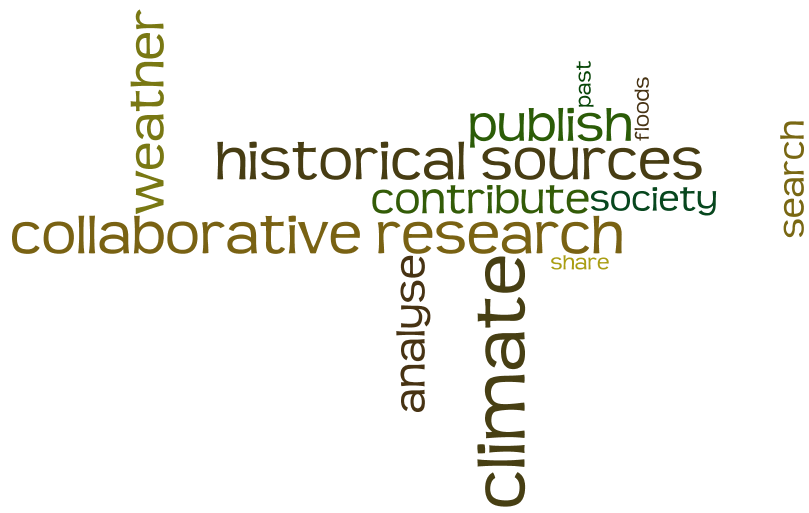Climate History Databases
Is there a database you'd like us to add? Contact Dr. Sam White with your suggestions.
The National Oceanic and Atmospheric Agency provides extensive databases of climate data obtained through proxies. For medieval and early modern historians the tree-ring (dendro) data is probably the most useful. The site also provides links to published climate data based on historical records. You can also search for data through the Paleoclimatology Data Map.
The Old World Drought Atlas, North American Drought Atlas, and Monsoon Asia Drought Atlas offer annual gridded reconstructions of dry/wet conditions based on networks of tree rings.
Tambora provides a database-supported infrastructure enabling the collaborative work on the interpretation of climate information derived from historical sources. The key information to be stored within the system is the original text quotation together with a bibliographic reference, place, time and coded information on climate and environment derived from the quote. The database has taken over information formerly in HISKILD (on early modern Germany) and is currently expanding.
The Japan Climate Data Project is building a database of documentary and early instrumental data on the weather and climate history of Japan and neighboring lands. The website also contains a full description of the current project, links, and publications based on its growing collections. Available in both in English and Japanese.
The Institute for Ocean Technology’s (Canadian) Ice Database consists of four freely accessible datasets:
1. Newfoundland Ice Extent. Contains reconstructed ice charts for the ice months January to April from 1810 to 1958 for ice conditions off the east coast of Newfoundland and the Grand Banks. It also contains the original ice reports from which the charts were drawn, along with data tables of the latitude and longitude of iceberg and sea ice sightings and the estimated ice edge.
2. Gulf of St. Lawrence Sea Ice Extent. This database is similar to the Newfoundland Ice Extent with information for the months November through June and is complete with tables and graphs.
3. Ship Collisions with Icebergs. This database describes collisions which have taken place in the northern hemisphere over the last couple of hundred years, principally on the Grand Banks and North Atlantic but also includes the waters of Alaska, Greenland and the Arctic.
4. Iceberg sightings. this database compiles all the recorded iceberg sightings since the late 1800s.
The National Center for Atmospheric Research (NCAR) has launched a tool for searching and evaluating climate data sets. NCAR explains the Climate Data Guide as “the go-to source for scientifically sound information and advice on the strengths, limitations, and applications of climate data. Experts who construct, evaluate, and compare climate data sets contribute their perspectives and advice on climate data and analysis methods for a broad community of data users. Users may participate by posting comments, questions, and links.” For now, there are only a few datasets going back more than a century, so it has limited use for historians. However, the searchability and clear evaluations of data make it a valuable tool for non-specialists.
The three-year research project Climates of Migration is a common project of The Rachel Carson Center for Environment and Society and the Institute for Advanced Study in the Humanities in Essen (KWI), funded by the German federal Ministry of Education and Research. The project looks at the historical intersections between environmental change and migration and is particularly interested in climate-induced movements of people in the past.
The Deutscher Wetterdienst operates Germany’s densest meteorological and climatological observing network. It has archived German weather observations that date back to the 18th century. In total, some 100 billion climate data entries have been gathered, processed, and archived. Click here to access the DWD's historical resources.
Glaciers, Climate, and Society is run by Mark Carey of the University of Oregon. It provides global information and resources related to glaciers hazards, climate change, and water. Within the website, users can access a glacier hazards bibliography, resources and links, and a K-12 education portal. In addition to these resources, the website features information on glacier hazards, climate change, and water-use research in the Andes.
The freely downloadable Climatological Database for the World's Oceans (CLIWOC) database represents the culmination of a project funded by the European Union and consists of 287,114 ship logs from the Dutch, English, French and Spanish navies. The vast majority of ship logs date from between 1750 and 1850, yet four ship logbooks were incorporated that predate 1750. Like papyrus scrolls for scholars of classical Egypt, ship logbooks, abounding with reliable meteorological information, form a vast and largely untouched documentary reservoir for historical climatologists.
Old Weather links scientists with citizen citizens with the aim of recovering Arctic and worldwide weather observations made by American ships since the mid-19th century. Their logs, freely available online, can then contribute to climate model projections, and will improve our knowledge of past environmental conditions. They can also be used to track past ship movements and tell the stories of people on board.
Red Española de Reconstrucción Climática a Partir de Fuentes Documentales (RECLIDO) includes historical climatology databases and projects covering medieval and early modern Spain.
As part of a joint United States-Canada initiative, the National Oceanic and Atmospheric Administration’s Great Lakes Environmental Research Laboratory (NOAA GLERL) combined the Canadian Ice Service Great Lakes Regional Charts with the U.S. National Ice Center (NIC) weekly charts to produce a digital database and ice cover climatology (ice charts of dates of first/last ice and ice duration, computer animations of the seasonal progression of ice cover for each winter, weekly statistical ice charts.) The GLERL database is the foundation for this atlas, which charts the distribution of ice on the Great Lakes since 1973.
The South Eastern Australian Recent Climate History (SEARCH) project is an interdisciplinary initiative to reconstruct the past 200-500 years of climate in SE Australia led by researchers from the University of Melbourne’s School of Earth Sciences.
The international Atmospheric Circulation Reconstructions over the Earth (ACRE) initiative both undertakes and facilitates the recovery of historical instrumental surface terrestrial and marine global weather observations to underpin 4D weather reconstructions (reanalyses) spanning the last 200-250 years for climate applications and impacts needs worldwide.
The website of the University of East Anglia Climatic Research Unit Includes links to paleoclimate and instrumental data used in climate reconstructions, as well as information about the center and its academic programs.
The Smithsonian's "Volcanoes of the World" database describes the physical characteristics of Holocene volcanoes and their eruptions. This search returns a list which may be filtered based on a volcano name, volcano type, features, evidence of recent activity, location (set using a map), country, rock types, population within various distance ranges, or the availability of images. Name and country searches will also return subfeature names and synonyms; using other filters will result in only primary volcano names being returned. A standard set of fields is shown on the screen display, but full results with additional content may be downloaded into an Excel spreadsheet.
With Euro-Climhist, evidence on weather and climate is made accessible through a user-friendly database query, including daily weather observations as well as extreme events and long-term climatic development.
Module 1: Weather and climate in Switzerland (1501-1999) (release 2 online since November 2015)
Module 2: Weather and climate in Europe during the Middle Ages (1000-1500) (in preparation)
Further modules are in the planning stage (following the area of modern counties and starting from 1500)
The International Data Rescue (I-DARE) Portal provides a single point of entry for information on the status of past and present worldwide to be rescued data and data rescue projects, on best methods and technologies involved in data rescue, and on metadata for data that need to be rescued.
The Reconstructed East Asian Climate Historical Encoded Series (REACHES) database is an ongoing project to digitize and standardize textual records of climate, and climate-related environmental changes, in Chinese history, from the second-century BCE until the modern era. Currently, only Qing records are available, but the database is steadily growing. A recent article explains the ongoing work.




















